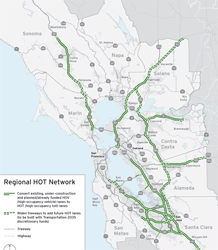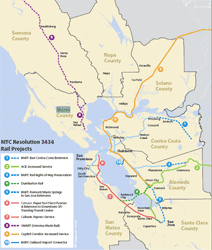The MTC’s Plan
On Wednesday the MTC of the San Francisco Bay Area boldly added an 800 mile high-occupancy toll, or HOT lane, network to its 25-year regional plan. These new lanes act as High-Occupancy Vehicle (HOV) (a.k.a. carpool) lanes but when there is extra capacity it is sold using an electronic toll. Traffic always keeps moving in the HOT lane because the lane uses congestion pricing: as more users begin to use the lane the toll rate automatically rises to deter more cars from using the lane before the decelerating effects of congestion set in. The first phase of this $3.7 billion project will install FasTrak electronic toll collection sensors on the entire 400-mile HOV lane network already in place in the San Francisco Bay Area. This will effectively convert the HOV lanes to HOT lanes. Subsequent phases will widen freeways to makes space for new HOT lanes rather than convert mixed flow lanes to HOT lanes.
Good for Transit? – Yes.
Besides having a really a sleek acronym, HOT lanes are a rather attractive idea. The MTC claims that the funds raised from the tolls will help improve the HOV network (now be called the HOT lane network) and that this will reduce congestion and emissions, and provide “a reliable travel option for express bus and carpools.” While, the MTC is somewhat amiss to claim the plan will “reduce” emissions, these new lanes do help transit gain a strategic edge over the automobile: In a way these lanes act as a kind of transit-first guideway because even when there is congestion on the mixed-flow lanes, and people really want to use the HOT lanes, the prices of the HOT lane will rise deterring automobile drivers but never the buses that will be whisking by parked cars on the freeways.
This might sound great, but it’s not the primary way the HOT lane network will support transit. Why? Rail. Take a look at the MTC’s Regional Rail Plan released last September and compare it to the Regional Hot-Lane Network announced today – there are clear similarities: these rail corridors parallel and compliment the freeway system. This is no coincidence – these corridors were designed to work as a transportation system that breaks the funding divide between roads and transit: the MTC envisions the HOT lane networking partially funding their nearly $50 billion rail proposal (see page 25).
Building more freeways is not the right way forward, but it’s (somewhat) inevitable for the time being. At the very least HOT Lanes provide a way to recoup the costs of, and even earn a profit from, freeway expansions. Transportation projects can earn money – the bridges in the Bay area alone earn over $400 million per year. If the profits from HOV lanes are used to put transportation on the fast track then they’re an excellent idea.
What’s Next?
There are gaps in the MTC’s HOT lane network, mainly either in San Francisco or directly connected to it. This is due to the high cost and infeasibility of adding lanes to these roads and bridges. Thus, the only way to expedite any sort of HOT lane network on these sections of roadway is to convert existing mixed-use lanes to HOT lanes. This has been studied, but it isn’t being done because of the experience that Santa Monica had in ‘taking away’ mixed flow lanes for use as HOV lanes.
Although the conversion of lanes in Santa Monica initially failed to reduce congestion and lawsuits were filed, by the time the lanes were converted back to mixed flow lanes, the HOV lanes had begun to work – people had switched to carpooling and taking the bus, it just took time. While this website promotes transit, there’s nothing wrong with getting freeway traffic to flow again. Let’s hope the MTC’s project is a success because if it is it may open the door to converting mixed-flow lanes to HOT lanes. Not only could this create a huge windfall for transit it would help avoid the tragedy of the commons on our freeways – a situation where nobody can get anywhere at all.

